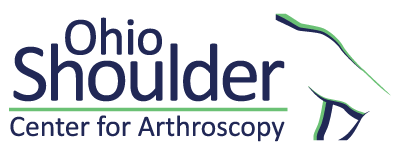Arthroscopic Rotator Cuff Repair Rehabilitation Protocol
- 1Phase I - Immediate Post Surgical/Maximum Protection (Weeks 1-6)
Goals:
- Protect integrity of repair
- Decrease inflammation and pain
- Improve passive range of motion (PROM)
Precautions:
- Maintain arm in abduction sling/brace, remove only for clothing/bathing
- No active range of motion (AROM) of shoulder
- No lifting of objects
- No shoulder motion behind back
- No excessive stretching or sudden movements
- No supporting of any weight No lifting of body weight by hands
- Keep incision clean and dry
Week 0-4 (Phase IA):
- PROM progressing per patient’s tolerance in Flexion and ER
- Pendulum exercises
- Elbow, wrist and hand ROM
- Postural instructions to promote active scapular retraction
- Scapular clock exercises
- Shoulder mobilization – posteriorly
- Ice and pain modalities as indicated
Week 4-6 (Phase IB):
- Continue PROM
- Begin PROM in Abduction per patient tolerance
- Shoulder mobs – posterior and caudal
- Pec minor flexibility
- Begin shoulder IR flexibility
- Begin isotonic scapular retraction /protraction
- Begin manual resistance scapular stabilization
- Begin Sub-max isometrics
- Shoulder flexion
- Shoulder abduction
- Shoulder extension
- Ice and pain modalities as indicated
Criteria for progression to the next phase (II):
- Passive forward flexion to at least 125°
- Passive ER in scapular plane to at least 75°
- Passive IR in scapular plane to at least 75°
- Passive Abduction to at least 90° in the scapular plane
- 2Phase II - Protection / AROM (Weeks 6-10)
Goals:
- Allow healing of soft tissue
- Minimize stress to healing tissue
Precautions:
- No lifting
- No supporting of body weight by hands and arms
- No sudden jerking motions
- No excessive behind the back movements
- Avoid upper extremity bike or upper extremity ergometer at all times
Week 6-8 (Phase IIA):
- D/C sling per physician
- AAROM per patient tolerance
- Proprioception exercise
- Ball on wall, UE swiss ball mobility –IR/ER
Week 8-10(Phase IIB):
- Begin progression of AROM per patient tolerance
- Avoid Scapular Substitution
Criteria for progression to the next phase (III):
- Full AROM avoiding scapular substitution
- Independent dressing ADLs
- 3Phase III - Basic Strengthening (Weeks 10-16)
Goals:
- Achieve/maintain full ROM
- Gradual restoration of shoulder strength, power, and endurance
- Optimize neuromuscular control
- Gradual return to functional activities
Precautions:
- No heavy lifting of objects (no heavier than 5 lbs.)
- No sudden lifting or pushing activities
- No sudden jerking motions
- No overhead lifting
- Avoid upper extremity bike or upper extremity ergometer at all times
Week 10-12 (Phase IIIA):
- Continue stretching and passive ROM (as needed)
- Dynamic stabilization exercises
- Light theraband/tubing exercises
- Shoulder IR/ER
- Horizontal Abduction / Adduction
- Begin Prone exercise program no weight
- Row
- Shoulder Extension
- Horizontal Abduction – T exercise position
- Lower Trap – Y exercise position
- Begin rhythmic stabilization exercises supine
Week 12-16 (IIIB):
- Progress T-band exercises
- Begin Diagonal Patterns
- Begin Prone exercise program with weight
- Row
- Shoulder Extension
- Horizontal Abduction – T exercise position
- Lower Trap – Y exercise position
- Progress Dumbbell Program with weight
- Scaption
- Diagonal patterns
- Bent row
- Prone Retraction with ER
- Functional eccentric strengthening
- Progress closed chain UE strengthening
- Push up with a plus
- Swiss ball activities
- Trunk and lower-extremity strengthening
Criteria for progression to the next phase (IV):
- Full AROM with no scapular substitution
- Able to tolerate the progression to low-level functional activities
- Return of strength/dynamic shoulder stability
- Adequate strength and dynamic stability for progression to higher demand activities
- 4Phase IV - Advanced Strengthening (Weeks 16-24)
Goals:
- Maintain full painless active ROM
- Improve muscular strength, power, and endurance
- Gradual return to full functional activities
Week (16-20):
- Continuation of functional UE/LE strengthening and endurance activity
- Stretching program with emphasis on posterior capsule
- Light sports (e.g., golf chipping/putting) if progressing

